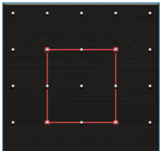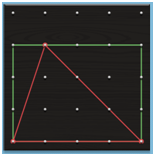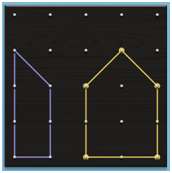Lesson 2
This math lesson focuses on area, which will be used to compute surface area of the birdhouses. Important: It is not the goal of this lesson to teach area formulas for triangles (or other figures) but to reinforce the conceptual framework of area: filling in a two-dimensional figure with square units (like tiles). Area is not "length times width;" area is an attribute of plane figures (3.MD.5b: A plane figure which can be covered without gaps or overlaps by n unit squares is said to have an area of n square units).
The mathematical purpose is for students to develop their understanding of area beyond "length times width," and to deeply explore two-dimensionality with the use of geoboards. Students should make use of the "length times width" area formula for rectangles (developed in third grade; 3.MD.C.7) to figure out the area of other figures. It is not a goal that they discover "one half base times height" area for triangles; if it does emerge from student exploration, it should be emphasized as a geometric idea, and not reduced to a formula. The “one half base times height” formula is not expected until 6th grade. In fourth grade, exploring the additive nature of area, decomposition and conservation of area are critical to bridge from third grade “area of a rectangle” work and sixth grade area of more general polygons via decomposition/composition (6.G.A.1).
Working in pairs, students will use geoboards to explore the area of
- squares
- rectangles in general
- right triangles
- non right triangles
- five sided composite figures (that could be decomposed into a rectangle and a right triangle)
The area of rectangles can be found using a variety of strategies, for example counting square units, counting by rows and skip counting or multiplying, leading to an understanding that multiplication is repeated addition, and informing the area model of multiplication. In third grade, students use these ideas to develop the fact that the area of a rectangle is the product of its side lengths (3.MD.C.7).
The area of triangles and composite shapes can be found using a variety of strategies, including adding strategies and subtracting strategies, separately or in combination. For example: a right triangle can be seen as half a rectangle; a five sided composite figure can be seen as the sum of its parts or as a larger rectangle with sections subtracted.
Activities
- Students work in pairs, report to whole class
- Each student has a geoboard
- (Each student has pencil and paper to record "noticings."
- Calling on students, list and sketch examples of many shapes used in birdhouses. We hope there will be at least rectangles and triangles. There may be squares, five sided shapes, non rectangular quadrilaterals, etc. It may come up that not all four sided shapes are rectangles. It may come up that all squares are rectangles.
- Show L-shaped figure on geoboard (either via document camera or with geoboard app http://www.mathlearningcenter.org/web-apps/geoboard/ )
“What do we mean by the area of this figure?”

- Review concept of "square unit." Demonstrate a "square unit" on geoboard.
- From the CCSS: “A plane figure which can be covered without gaps or overlaps by n unit squares is said to have an area of n square units” (3.MD.C.5.B)
- For now, we will have a rule with the shapes we make on the geoboard: all shapes must have at least one side that is aligned (parallel) to an edge of the geoboard.
- Find and describe ways to figure out the area of a square on your geoboard
- Find and describe ways to figure out the area of a rectangle (that might not be a square) on your geoboard
- Find and describe ways to figure out the area of a right triangle on your geoboard
- Find and describe ways to figure out the area of any triangle on your geoboard
- Find and describe ways to figure out the area of other shapes from the birdhouses
With all four parts of the task statement on the screen or board, a whole-class brief discussion ensures that everyone remembers what “area” means and what a right triangle is. The rule for today that our shapes will have at least one side that is aligned (parallel) with a side of the geoboard is also established.
Students work in pairs on parts 1 and 2, then share solutions so as to bring out the four methods in “Solution” below. (This should be brief, as this content should have been developed in third grade.)
Next, pairs work on part 3 of the task, with the intended discovery of a right triangle as half of an appropriate rectangle. Strategies and drawings are shared.
Finally, part 4 is explored, with the hope that various strategies of decomposition and composition can be highlighted. In particular, surrounding a triangle with a rectangle (whose area can easily be computed) leads to a subtractive strategy.
If a pair quickly has a method, ask them to explain why it works, and to write a description of their method; then they can find another method.
When all pairs have found at least one method and all four methods in the solution have arisen, call on pairs to share each of the four methods
For parts 1 and 2, try to ensure that these four methods all arise, along with reasonable justification:
- Count squares
- Count squares in a row, add repeatedly to get total
- Count squares in a column, add repeatedly to get total
- Multiply length times width
The key “take-aways”
- Area: number of unit tiles that it takes to cover a shape with no overlap. The squares might be partial squares
- For some shapes (rectangles, at this point), we might have a convenient formula to figure out the area
- Area is additive: A figure can be cut up into multiple shapes, and the areas of the smaller shapes add up to the area of the original.
When pairs are working, be careful to maintain cognitive demand by not jumping in with questions or suggestions too quickly.
Students pairs:
Each makes a square (of any size each individual chooses).
- How do you know it's a square? convince partner.
- How many square units fill your square, with no overlaps or gaps? How did you figure that out? Explain to partner.
- Each makes a different sized square (from first square). How do you know it's a square? Convince partner.
- How many square units to fill your square, with no overlaps or gaps? How did you figure that out? Explain to partner. (Keep notes of strategies and "noticings.")
Teacher:
- Did we notice anything? (Did we notice that all sides had right angles? Did we notice that if one side was aligned/parallel with a geoboard side, all sides were? Did any interesting counting/multiplying strategies emerge?)
(For this shape or any of the following, teacher may choose to put the shape on a geoboard on an elmo or projected on: http://www.mathlearningcenter.org/web-apps/geoboard/

- Now we will make a rectangle other than a square. We still have the rule that at least one side of the rectangle must be aligned (parallel) with one side of the geoboard.
Student pairs (repeat activity used with squares).
Teacher:
- (Brief debrief of rectangles). Let's try triangles. Our first triangles should have two sides aligned with sides of the geoboard. (Demonstrate a right triangle.) These will be a little harder to find the square units, but let's try!
Student pairs (repeat activity used with squares. If students struggle with half a rectangle, they can be coaxed into estimating. They can count whole square units and partial square units and use that to estimate their area. Students may need a little nudging to see a right triangle as half of a rectangle. Hopefully someone will and can report back. If no one does, teacher can help them "discover" this strategy. Student pairs do two rounds of right triangles, then report, then do two more rounds of right triangles.)
Teacher:
- What strategies did we use to find area? Did we notice anything? (Students should all get the opportunity to use the strategy of making a rectangle which shares two sides with the right triangle, and seeing that the right triangle is half the rectangle. This may be modeled by the teacher after students have had a chance to discover it on their own.)
- Now we'll make triangles where one side is aligned (parallel) with one side of the geoboard, but the other two sides are not.
Student pairs (repeat activity used with right triangles.)
Teacher:
What strategies did we use to find area? Did we notice anything? (Teacher may choose to model student answers with geoboard, or to make suggestions using geoboard.)

(Teacher goes to an unusual shape from the list of birdhouse shapes, for example shapes like these. Whole class discussion on how to find area of shapes.)

- Students in pairs explore shapes and strategies for finding area of the shapes, which might be additive and/or subtractive and/or involve estimating.
Synthesis
Teacher will call on a few students to demonstrate area of shapes. Ideally, all shapes collected at the end of building the final birdhouses should be explored.

